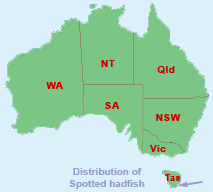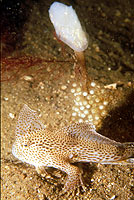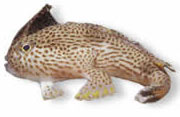Tasmania - Spotted Handfish
Ros Asten, MESA Tasmanian Rep
Woodbridge Marine Discovery Centre, TAS
Status - Endangered

Spotted handfish
Image courtesy © Mark Green
|
The spotted handfish is a member of the family Brachionichthyidae (handfishes), and are closely related to anglerfish. They are a small fish, growing to around 12cm in length, white or cream in colour with numerous small orange or brown spots. The arrangement of these spots is unique to each fish, and can be used to identify individuals.
The pectoral fins of handfish bear a resemblance to a human hand, hence their common name. They move by slowly ‘walking’ along the sea floor with the pectoral fins and pelvic fins rather than swimming.
Protected in Tasmania since 1994, the spotted handfish has the dubious distinction of becoming the first marine fish to be listed as endangered under the Commonwealth Endangered Species Protection Act in 1996. |
The spotted handfish has three close relatives listed as vulnerable on the Tasmanian Threatened Species List: the red handfish, Ziebell’s handfish, and the Waterfall Bay handfish. These species are found only in restricted habitats in south eastern Tasmania.
The spotted handfish is endemic to Tasmania and is only found in the Derwent Estuary and adjoining bays in the south east of the State, close to Hobart. See the distribution map on the Tasmanian Department of Primary Industries and Water website.
Spotted handfish are bottom dwelling and live on sandy or silty sediments at depths of between 2 and 30 metres. Within their range, the handfish live in colonies, groups of fish that breed together.
It is believed that spotted handfish eat small crustaceans such as amphipods, small molluscs and polychaete worms.
|
 |
| |
|
|

A female Spotted handfish
Her eggs are behing her
around the ascidian.
Image courtesy © Mark Green |
Spawning occurs during September and October. The female lays between 80 and 250 eggs around the base of a vertical object on the sea floor, commonly the stalked ascidian, or sea squirt, Sycozoa sp. She stays to watch over her eggs, which take around 7 to 8 weeks to hatch.
Spotted handfish do not go through a larval stage, but hatch from their eggs as juvenile fish 6-7mm in length. Juvenile spotted handfish do not move far from the site of their spawning. This habit, combined with the lack of larval stage, has led to the very restricted range of the fish and increases its vulnerability to threatening processes. |

A juvenile spotted handfish
Image from
Derwent Estuary Organisation website |
more ... |
|





